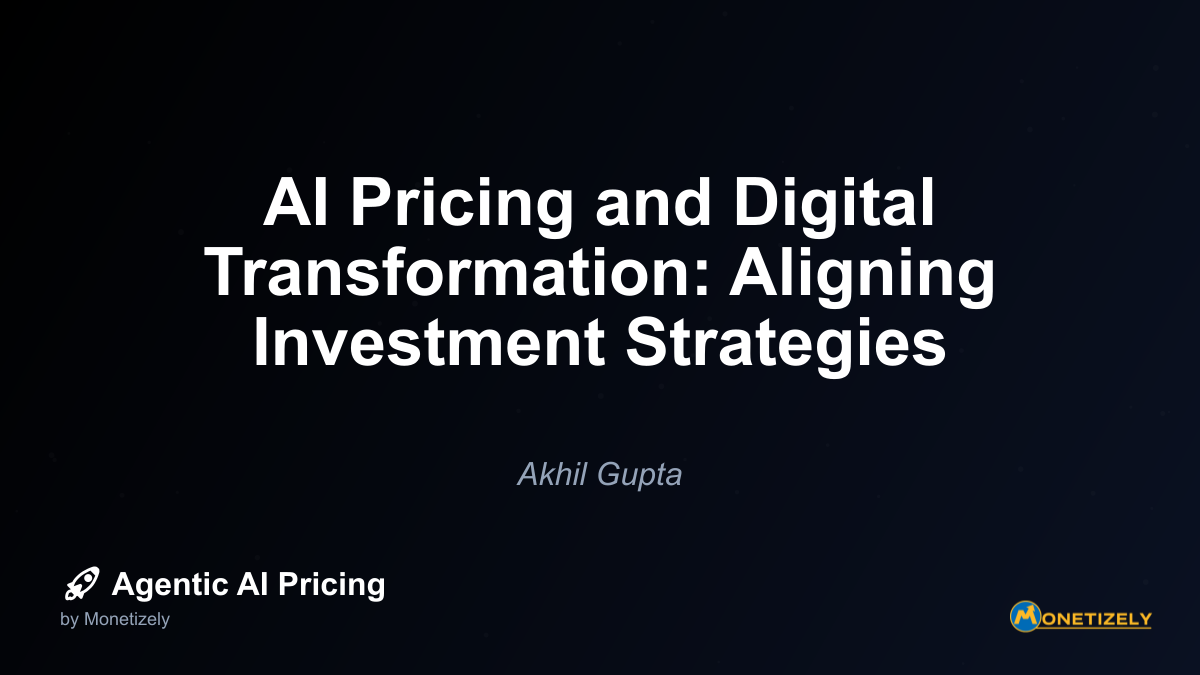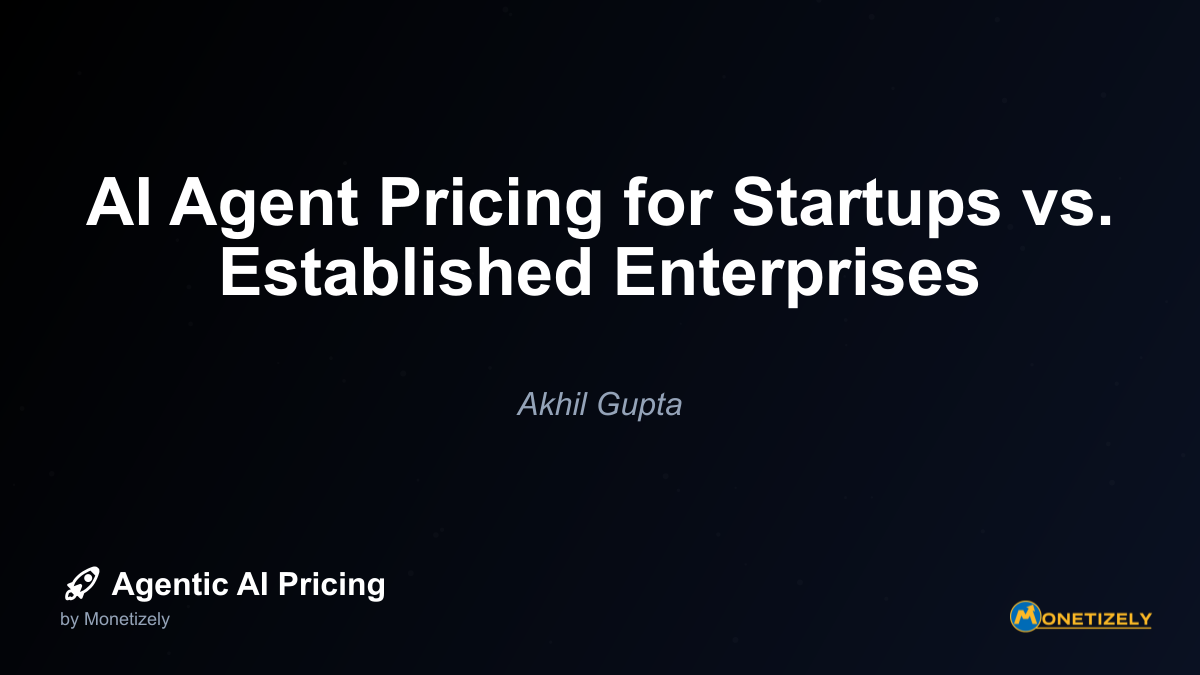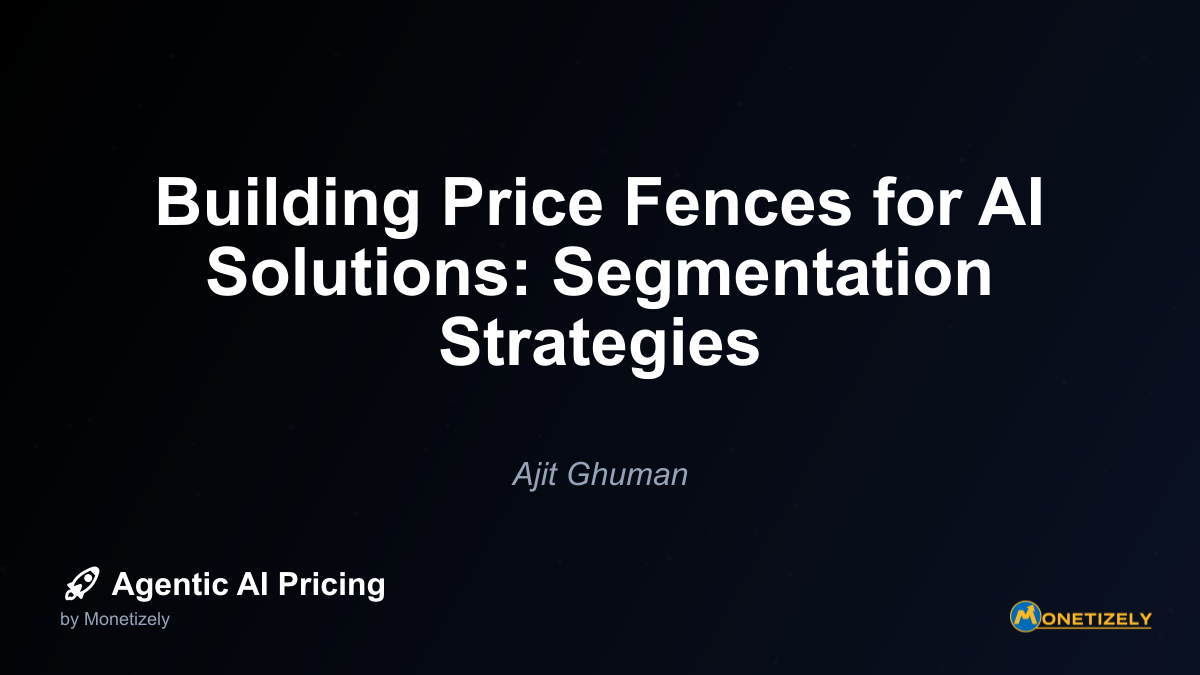· Akhil Gupta · Strategy · 14 min read
AI Pricing and Digital Transformation: Aligning Investment Strategies
AI and SaaS Pricing Masterclass
Learn the art of strategic pricing directly from industry experts. Our comprehensive course provides frameworks and methodologies for optimizing your pricing strategy in the evolving AI landscape. Earn a professional certification that can be imported directly to your LinkedIn profile.

In today’s rapidly evolving business landscape, organizations are increasingly recognizing the strategic importance of aligning AI pricing initiatives with broader digital transformation efforts. This alignment is not merely a technical consideration but a fundamental business strategy that can determine competitive advantage, operational efficiency, and long-term growth. As enterprises navigate the complex intersection of artificial intelligence and digital transformation, understanding how to position AI agent pricing within this broader context becomes essential.
The Evolution of AI Pricing in Digital Transformation
Digital transformation has evolved from a buzzword to a business imperative, with the global digital transformation market valued at approximately $911 billion in 2024 and projected to reach $3.3 trillion by 2030, growing at a compound annual growth rate (CAGR) of 23.9%. Within this landscape, AI has emerged as a critical driver, with its own market expanding at an even more impressive CAGR of 37.3% from 2023 to 2030, targeting a value of $1.85 trillion.
The integration of AI pricing strategies within digital transformation initiatives represents a significant shift from traditional pricing approaches. Historically, pricing decisions were often based on intuition, limited market data, and reactive adjustments. Today, AI-powered price optimization algorithms analyze vast quantities of data in real-time, enabling organizations to improve margins by up to 10%, enhance competitive positioning, and increase customer satisfaction.
From Static to Dynamic: The Transformation of Pricing Models
The evolution of pricing models reflects the broader digital transformation journey:
- Traditional Static Pricing: Fixed prices with periodic manual adjustments
- Rules-Based Dynamic Pricing: Automated adjustments based on predefined rules
- AI-Augmented Pricing: Human decision-making enhanced by AI recommendations
- AI-Driven Dynamic Pricing: Algorithmic pricing with human oversight
- Autonomous Agentic Pricing: Self-learning AI agents making pricing decisions with minimal human intervention
This progression mirrors the overall digital maturity curve that organizations navigate during transformation initiatives. Companies like Amazon and eBay exemplify successful AI-driven pricing strategies, continuously adjusting prices in real-time based on market signals to boost sales and revenues.
Strategic Framework for Aligning AI Pricing with Digital Transformation
Successful integration of AI pricing within digital transformation requires a comprehensive strategic framework that addresses technical, organizational, and financial considerations.
1. Strategic Alignment and Vision
The first step in positioning AI pricing within digital transformation is establishing clear strategic alignment. This involves:
Defining Transformation Objectives: Articulate how AI pricing contributes to broader digital transformation goals such as customer experience enhancement, operational efficiency, or new business model creation.
Establishing Value Metrics: Identify specific, measurable outcomes that AI pricing will drive, such as margin improvement, competitive response time, or customer lifetime value.
Securing Executive Sponsorship: Ensure C-suite understanding and support for AI pricing as a strategic transformation initiative, not merely a technical implementation.
According to McKinsey, while 90% of companies initiate digital transformations, only about one-third of expected revenue benefits typically materialize. This gap often stems from failing to integrate technology with core processes, upskill employees, and foster a culture of continuous digital innovation.
2. Technical Integration Framework
The technical aspects of integrating AI pricing within digital transformation require careful consideration:
Agentic AI Capabilities: Modern AI pricing solutions deploy autonomous agents that analyze data, make pricing decisions, and execute actions with minimal human oversight. These agents leverage Large Language Models (LLMs) with enhanced reasoning and adaptive learning capabilities.
Integration Architecture: AI pricing agents typically function as overlays or enhancers to existing enterprise software platforms like ERP or CRM systems, filling functional gaps and optimizing pricing workflows in real-time. This integration is commonly facilitated through APIs and cloud-based orchestration to ensure scalability and reliability.
Data Strategy: Successful AI pricing implementations require a comprehensive data strategy that addresses data quality, integration, governance, and privacy concerns. Organizations must establish data pipelines that connect pricing-relevant information across the enterprise.
Hyperautomation Approach: AI pricing agents often form part of a broader hyperautomation strategy, combining AI, machine learning, and robotic process automation (RPA) to streamline end-to-end pricing processes—such as competitor price monitoring, demand forecasting, and dynamic price adjustments.
A German energy provider exemplifies this approach, having developed a custom generative AI tool to automate payment review and spot overpayments by comparing invoices with contracted prices. Developed in just 10 weeks, this tool is projected to generate tens of millions of dollars in value by reducing costs directly.
3. Organizational Change Management
The human dimension of aligning AI pricing with digital transformation is often the most challenging aspect:
Stakeholder Alignment: Since 47% of buyers struggle to define measurable outcomes and 25% have difficulty aligning value with vendors, enterprises must involve cross-functional stakeholders (finance, sales, IT, pricing teams) early to agree on clear KPIs around AI pricing agent impact.
Capability Development: Organizations need to shift employee roles from manual pricing tasks to oversight and strategic decision-making, requiring upskilling in AI interpretation and governance.
Cultural Transformation: Building trust in AI-driven pricing decisions requires transparency, explainability, and effective feedback loops. Culture change programs should address resistance to algorithmic decision-making.
Governance Frameworks: With AI agents making autonomous pricing decisions, controls must be implemented to mitigate risks such as unintended biases, pricing errors, or compliance violations. This involves setting governance frameworks and continuous monitoring aligned with corporate AI ethics policies.
The World Economic Forum advocates a strategic roadmap to scale AI adoption, focusing on high-impact use cases while sharing best practices and lessons learned to accelerate growth and avoid pitfalls. This includes developing AI governance alliances across industries to harmonize standards in the age of AI-driven transformation.
4. Financial Models and Investment Alignment
Aligning financial models and investment strategies for AI pricing within digital transformation requires sophisticated approaches:
ROI Calculation Frameworks: Traditional ROI models often fail to capture the full value of AI pricing initiatives. Advanced frameworks should incorporate direct benefits (margin improvement, revenue uplift), indirect benefits (improved decision quality, faster response time), and strategic value (competitive positioning, market intelligence).
Outcome-Based Pricing Models: Enterprises increasingly adopt pricing schemes that tie cost to measurable business outcomes delivered by AI pricing agents. This requires defining clear KPIs upfront and utilizing data analytics to track value creation versus spend over time.
Investment Staging: Rather than a single large investment, successful organizations often stage AI pricing investments to align with digital transformation maturity. This might begin with proof-of-concept implementations in specific product categories or market segments before scaling enterprise-wide.
Risk Mitigation Strategies: Financial models must incorporate sensitivity analyses considering variability in AI-driven pricing outcomes and potential impacts from external market factors outside AI control. Scenario modeling helps balance pricing innovation with revenue predictability.
Semiconductor firm AMD partnered with a software company to implement a genAI supply chain tool that analyzed over 10,400 orders annually. This saved about 3,120 labor hours and cut root-cause analysis time and cost by 90%, significantly boosting operational efficiency.
Competitive Landscape: Major Players and Their Approaches
Understanding how major AI vendors position their pricing strategies provides valuable insights for enterprises planning their own implementations.
OpenAI
OpenAI typically employs a usage-based pricing model, charging enterprises based on the number of API calls, tokens processed, or compute resources consumed. This aligns with the high compute costs inherent in running large language models that power autonomous agents. OpenAI’s pricing emphasizes flexibility for customers scaling usage, but it also means costs can spike unpredictably with heavy or variable use. Their enterprise plans often include premium support, guaranteed uptime, and enhanced security for deep integrations.
Microsoft
Microsoft, leveraging its Azure cloud platform and partnership with OpenAI, integrates agentic AI solutions into their Azure AI services. Pricing is often a hybrid of fixed enterprise contracts plus variable consumption-based billing tied to Azure resource usage (compute hours, storage, API calls). Microsoft differentiates by bundling agentic AI capabilities into broader enterprise cloud suites, appealing to customers prioritizing end-to-end scalability, compliance, and integration with Microsoft 365 and Dynamics 365 products.
Microsoft-collaborating firms like NTT DATA have automated up to 65% of service desk tasks and 100% in some order workflows, achieving productivity gains and faster time to market. Noventiq reported saving 989 hours on routine tasks within just a month, translating to measurable value enhancements.
Google Cloud’s agentic AI offerings are priced similarly with a pay-as-you-go model based on consumption metrics such as CPU/GPU usage, TPU hours, and number of invoked AI endpoints. Google places strong emphasis on price-performance optimization and offers discounted committed use contracts. Google differentiates through its proprietary AI APIs and orchestration frameworks that support complex multi-agent workflows and fine-tuned automation for enterprise needs.
Amazon Web Services (AWS)
AWS adopts a flexible pricing strategy with a range of AI agent services integrated into AWS AI and machine learning ecosystems (e.g., Amazon SageMaker and AWS Lambda). Pricing involves variable compute-time charges, data storage fees, and API request costs, often bundled with advanced infrastructure options for scalability. AWS emphasizes integration with broader cloud-native products, high availability, and enterprise-grade orchestration.
Anthropic
Anthropic, a key AI startup focused on safe and scalable AI models, offers enterprise-grade agentic AI through API usage fees based on token consumption and compute intensity. Their pricing is competitive but usually targets customers highly sensitive to safety, compliance, and reliability aspects. Differentiators include value-based pricing tied to outcomes and safety guarantees, appealing specifically to regulated industries requiring AI transparency and control mechanisms.
Other Key Players
- IBM and Salesforce have introduced agentic AI solutions integrated tightly into their enterprise platforms with hybrid pricing of license fees plus consumption tiers charged by AI task execution volume.
- Emerging startups push value-based pricing models that balance SaaS predictability with cloud usage flexibility, often offering trials or tiered plans to ease entry for enterprises testing autonomous agents.
Implementation Strategies: From Concept to Execution
Successful implementation of AI pricing within digital transformation initiatives requires a structured approach that balances innovation with pragmatism.
1. Assessment and Readiness
Before implementation, organizations should conduct a comprehensive assessment of their readiness for AI pricing integration:
Digital Maturity Assessment: Evaluate the organization’s overall digital transformation maturity, including data infrastructure, technology stack, and organizational capabilities.
Pricing Process Analysis: Document existing pricing processes, decision points, data sources, and stakeholders to identify opportunities for AI enhancement.
Data Readiness Evaluation: Assess the quality, accessibility, and completeness of pricing-relevant data across the organization.
Skills Gap Analysis: Identify the capabilities required for successful implementation and maintenance of AI pricing systems, and determine any skill gaps that need to be addressed.
2. Pilot Implementation
A pilot approach allows organizations to test AI pricing concepts in controlled environments before scaling:
Use Case Prioritization: Select high-value, low-risk use cases for initial implementation, such as pricing optimization for specific product categories or market segments.
Agile Implementation: Adopt an agile approach with rapid development cycles (e.g., 10-week custom tool creation) to enable swift deployment and value realization.
Baseline Establishment: Define clear metrics and establish baseline performance to measure the impact of AI pricing initiatives.
Feedback Mechanisms: Implement robust feedback loops that capture insights from both system performance and stakeholder experiences.
3. Scaling and Integration
Once pilot implementations prove successful, organizations can scale AI pricing across the enterprise:
Integration Roadmap: Develop a phased approach to integrating AI pricing with other enterprise systems and digital transformation initiatives.
Change Management Program: Implement a comprehensive change management program that addresses both technical and human aspects of the transformation.
Governance Framework: Establish clear governance mechanisms for AI pricing decisions, including oversight, audit trails, and exception handling.
Continuous Learning: Implement mechanisms for continuous improvement of AI pricing models based on performance data and changing market conditions.
Nykaa, a beauty and fashion e-commerce platform, boosted developer productivity by 20% using AI code completion tools, resulting in substantial cost savings and quicker feature releases. This approach to scaling AI capabilities across the organization demonstrates the potential for significant operational improvements.
Future Trends and Strategic Considerations
As organizations look to the future, several trends and considerations will shape the alignment of AI pricing with digital transformation initiatives.
Emerging Trends in AI Pricing
AI and Generative AI Integration: Sophisticated pricing strategies will increasingly depend on AI and generative AI (GenAI) to analyze complex market data and customer behavior dynamically. These technologies enable real-time, granular pricing adjustments responsive to market volatility and customer demands.
Dynamic and Ethical Pricing: Companies face threats like price volatility and need to balance dynamic pricing with fairness considerations due to rising consumer and regulatory scrutiny. Fairness is becoming a paramount principle to avoid technological or commercial overreach that could harm brand trust.
Hyperautomation and AI Agentic Systems: Enterprises will leverage hyperautomation—combining AI, machine learning (ML), and robotic process automation (RPA)—to automate entire pricing workflows, enhancing efficiency and scalability. Agentic AI (autonomous AI agents) integrated into pricing decision systems will allow faster, smarter decisions, radically streamlining pricing processes.
Software Business Model Shifts: AI agents reshaping demand for software platforms may lead software vendors to pivot from large-scale infrastructure investments to more tailored AI-driven pricing and business solutions, impacting costs and pricing approaches offered to enterprises.
Regulatory Considerations
The regulatory landscape for AI pricing is evolving rapidly and will significantly impact implementation strategies:
Fairness and Transparency Requirements: Regulators are increasingly focused on ensuring that AI pricing algorithms do not discriminate against specific customer segments or exploit information asymmetries.
Data Privacy Regulations: The collection and use of customer data for AI pricing must comply with evolving privacy regulations such as GDPR, CCPA, and emerging global standards.
Algorithmic Accountability: Organizations may face requirements to explain and justify AI-driven pricing decisions, particularly in regulated industries or when significant price differentials are applied.
Cross-Border Considerations: Global organizations must navigate varying regulatory requirements across jurisdictions, potentially requiring different approaches to AI pricing in different markets.
Strategic Recommendations
Based on current trends and best practices, organizations should consider the following strategic recommendations:
Adopt an Integrated AI Pricing Strategy: Align AI pricing with broader business and digital transformation goals. Consider market volatility, sustainability, and fairness risks carefully.
Pilot AI-Powered Pricing Automation: Start with high-impact, repetitive pricing workflows for automation using agentic AI and hyperautomation to maximize ROI and efficiency gains.
Invest in Data Quality and Governance: High-quality, standardized data is crucial to effective AI pricing and regulatory compliance. Enhance data infrastructure and governance as foundation.
Focus on Transparency and Ethics: Build trust via transparent AI pricing models and ensure compliance with emerging ethical and regulatory standards.
Continuous Monitoring and Adaptation: Use AI’s predictive power to continuously monitor pricing effectiveness, customer response, and market shifts to optimize strategy dynamically.
Case Studies: Learning from Leaders
Examining how leading organizations have aligned AI pricing with digital transformation provides valuable insights for others on this journey.
Case Study 1: Global Energy Provider
A German energy provider developed a custom generative AI tool to automate payment review and identify overpayments by comparing invoices with contracted prices. This initiative was part of a broader digital transformation effort focused on operational efficiency and cost reduction.
Implementation Approach:
- Rapid development cycle (10 weeks) using agile methodology
- Integration with existing billing and contract management systems
- Training of AI models on historical invoice and contract data
- Phased rollout starting with highest-value contract categories
Results:
- Projected tens of millions of dollars in value through cost reduction
- Significant improvement in payment accuracy
- Redeployment of finance staff to higher-value activities
- Enhanced contract compliance and supplier management
Key Lessons:
- Focus on high-value use cases with clear ROI
- Rapid development and deployment can accelerate value realization
- Integration with existing systems is critical for success
- AI can complement rather than replace human expertise
Case Study 2: Semiconductor Manufacturer
AMD partnered with a software company to implement a generative AI supply chain tool that analyzed over 10,400 orders annually. This initiative was part of a comprehensive digital transformation program focused on supply chain optimization and operational efficiency.
Implementation Approach:
- Collaborative partnership with specialized AI vendor
- Focus on specific high-volume supply chain processes
- Integration with existing ERP and supply chain management systems
- Comprehensive training program for supply chain analysts
Results:
- Saved approximately 3,120 labor hours annually
- Reduced root-cause analysis time and cost by 90%
- Improved supply chain visibility and responsiveness
- Enhanced decision-making quality and consistency
Key Lessons:
- Strategic vendor partnerships can accelerate implementation
- Process-specific AI applications can deliver rapid returns
- Training and change management are critical success factors
- Measurable outcomes help justify continued investment
Case Study 3: Technology Services Provider
NTT DATA implemented AI-driven automation for service desk operations and order workflows as part of a broader digital transformation initiative. This implementation focused on customer experience enhancement and operational efficiency.
Implementation Approach:
- Comprehensive process analysis to identify automation opportunities
- Development of AI-powered chatbots and automated workflow systems
- Integration with existing service management platforms
- Phased implementation with continuous feedback and improvement
Results:
- Automated up to 65% of service desk tasks
- Achieved 100% automation in some order workflows
- Significant productivity gains and faster time to market
- Enhanced customer satisfaction through faster response times
Key Lessons:
- Process standardization is a
Co-Founder & COO
Akhil is an Engineering leader with over 16+ years of experience in building, managing and scaling web-scale, high throughput enterprise applications and teams. He has worked with and led technology teams at FabAlley, BuildSupply and Healthians. He is a graduate from Delhi College of Engineering and UC Berkeley certified CTO.
Pricing Strategy Audit
Let our experts analyze your current pricing strategy and identify opportunities for improvement. Our data-driven assessment will help you unlock untapped revenue potential and optimize your AI pricing approach.




